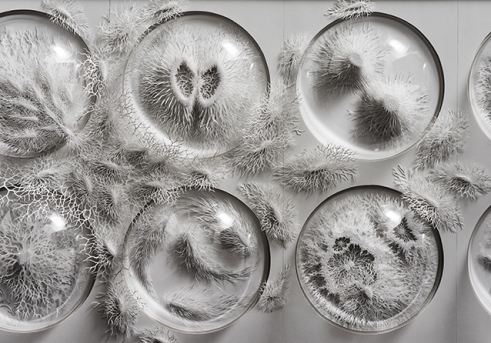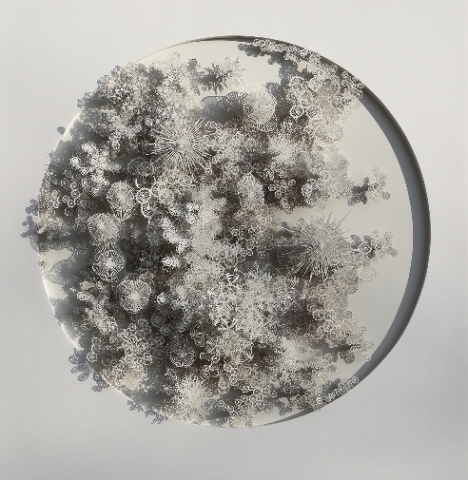Art Imitating Life

Artist Rogan Brown's exquisite sculptures – mostly cut by hand – are inspired by the patterns and forms of the microbial world
The Biologist 64(2) p18-19
Artist Rogan Brown became interested in scientific illustration after moving to a wild and rural forest in southern France. He wanted to capture the natural world that surrounded him, but felt traditional ways of describing it, such as landscape painting, were too old-fashioned.
"I began the paper cuts to move away from painting and I soon realised I was really dissecting the paper with a scalpel in a scientific fashion," says Brown. "The preparatory drawings I made were meticulously detailed, again like scientific illustrations. I had a eureka moment when I understood I was looking at nature through the prism of science, because science has radically altered the way we perceive nature."
He says that whereas Romantic painters of the past saw the world in "mystical, quasi-religious terms", people now see the world "through the microscope lens, the telescope, the satellite and the MRI scanner".
Brown has grown his own bacterial colonies and learned to use a microscope, but takes most of his inspiration from scientific images and illustrations.
"I spend a great deal of time looking at images of cell structures, bacteria, viruses and other microbiological organisms," he says. "There are certain key texts to which I keep returning: the stunning anatomical etchings in Andreas Vesalius' De humani corporis fabrica; The Temple of Flora, Robert Thornton's 18th century book of botanical illustrations that mix science and romanticism; the great 19th century artist-scientist Ernst Haeckel's incredible illustrated book, Art Forms in Nature; and the work of Nobel Prize-winning neuroscientist and artist Santiago Ramon y Cajal, whose drawings of the neurons of the human brain are some of the most beautiful biomorphic abstracts I have ever seen."
"The circle of the title refers not only to the shape of the petri dish and the microscope lens, but also to the Buddhist mandala, as these pieces encourage meditation on the beauty and intricacy of the natural world."
"The Eden Project and the Wellcome Trust commissioned this image of a flagellate bacterium for a permanent exhibition dedicated to the human microbiome. The aim was to create a powerful, visceral representation of a bacterium that engaged the public's attention and encouraged them to delve deeper into the exhibition. Inspired by Escherichia coli and Salmonella bacteria, it took four months to cut by hand."
'Outbreak'

"This installation took four months to cut and build. It was inspired by a meeting with a group of microbiologists who were planning a new exhibition centre focusing on the human microbiome. I wanted to create a piece that examined our fears of the microbiological world, so out of one of the petri domes a group of organisms bursts forth, full of ferocious, uncontrollable energy."
You can find more of Rogan's work at roganbrown.com




